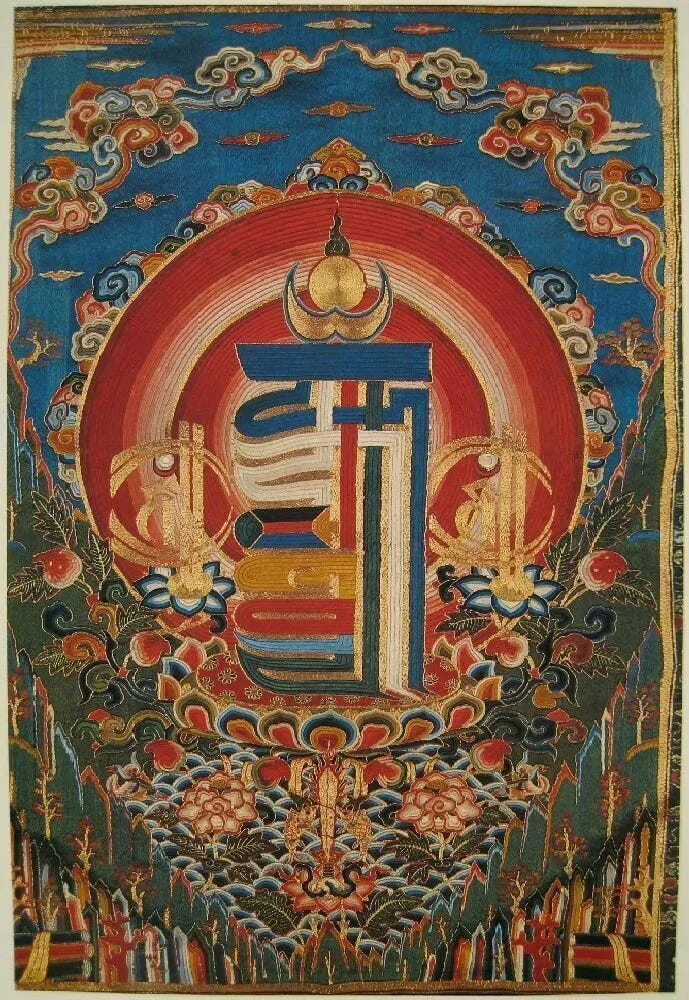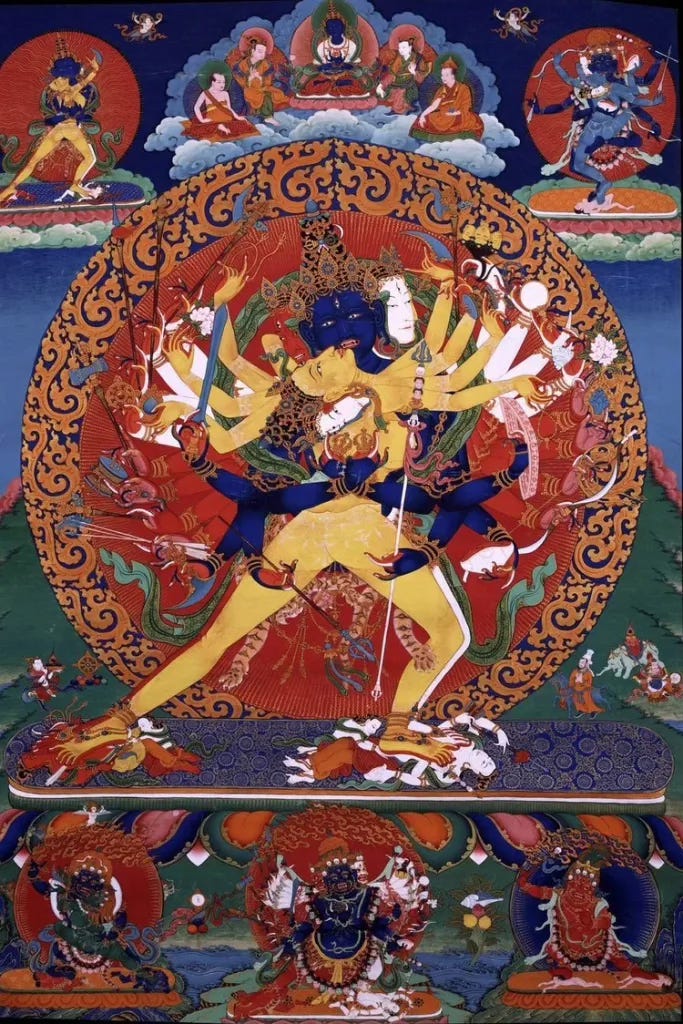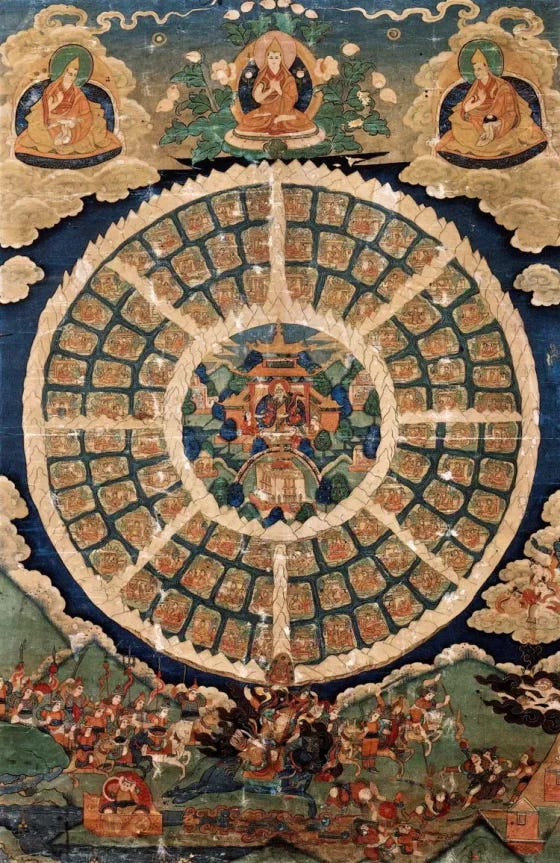Dear Reader:
I hope you have been well. I’m traveling in Northern Italy this week, so I won’t be publishing a keyword. But the next one, “tathāgata,” will be out this Sunday, so stay tuned. Here, I’m publishing a story I had on my previous substack, seeking to unveil the cultural unconscious of the European encounter with the Buddha in the Age of Enlightenment. This story, let’s put it this way, is a preliminary assessment of some of the narratological aspects of the Kālacakra Tantra.
See you Sunday.
Martino

The Kālacakra (“Wheel of Time”) Tantra is a corpus of Buddhist scriptures and commentaries compiled in India in the early decades of the eleventh century. “Tantra” is a Sanskrit term meaning “book,” or “manual.” In this sense, the Kālacakra Tantra is a manual on what is perhaps the last, great system of practice to emerge in India before the demise of Buddhism in the fourteenth century.
Three centuries earlier, in the first decades of the eleventh century, the early Muslim emperors of Inner Asia had begun to invade and occupy the northeastern regions of India. Around the same time, Muslim scholars also began to compile erudite accounts of the languages, institutions, religious practices, and rules of conduct of the Hindus in the Arabic language.
During the early encounter of Muslim scholars with Buddhist India, the compilers of the Kālacakra Tantra articulated in Sanskrit a prophetic vision of the Buddha’s teachings in a series of holy books. The first of these books was the Ādibuddha: the Kālacakra mūla, or “root,” tantra. The second was the Śrī Kālacakra: the laghu, or “abridged,” tantra. The third was the Vimalaprabhā: the ṭīkā, or “commentary,” on the mūla and laghu tantra together.
Early on, in both India and Tibet, Buddhist historians and exegetes agreed on the following. Because the commentaries, that is, the the Śrī Kālacakra and the Vimalaprabhā, contained several fragments of the Ādibuddha, the Śrī Kālacakra and the Vimalaprabhā presupposed the existence of the root tantra. Still, like other Buddhist mūla tantras, when the laghu tantra and the ṭīkā were written down in Sanskrit, the holy book of prophecies was said to have long been lost. Although the Buddha was said to have preached the mūla tantra in Southern India, the text had been taken to the fabulous realm of Sambhala, where it had been written down and where its instructions had been preserved by a lineage of wise and benevolent kings.
Even when fragments of the Ādibuddha circulated as independent texts in India, and when early commentators claimed to have read the holy book upon their visits to Sambhala, the lost original could be said to have existed, as long as it remained inaccessible to readers in the form of a book—a book preserved in an invisible realm. Under this light, the Ādibuddha instituted its authenticity as the expression of an originating truth named Ādi Buddha: the supreme Kālacakra deity, an awakened being whose power and knowledge reached beyond space and time.

Like the Ādi Buddha, that is, the original speaker of the tantra, whose teaching of the Dharma was displaced to a primordial time, the Ādibuddha instituted itself as an absence.
Irretrievable in the present, then, the fragments of the Ādibuddha that circulated independently in India evoked this primordial time. In evoking the Buddha’s prophetic memories of past, present, and future events, however, the anonymous author of the Kālacakra Tantra also provided her readers with future memories of the Buddha. These were memories which, in future times, were said to be capable of providing Indian Buddhists with the power to save the Dharma from Muslim invaders.
Considering the above, on a narrative level the Ādibuddha poses an enigma. If the readers of the Kālacakra Tantra could gain any insight into the future of the Buddha’s Dharma after the Muslim conquest of India, this future could be seen as a reflection through the fragments of the mūla tantra—the fragments of the Ādibuddha embedded in the Śrī Kālacakra and in the Vimalaprabhā.

For, in the Kālacakra tantra, the Buddha is none other than a prophet. Yet, the Buddha is not a prophet here as understood in the great monotheistic religions of Christianity, Judaism, and Islam. Renowned in the Indian tradition as the devātideva, a Sanskrit term often translated as the “god beyond the gods,” the Buddha is himself often said to be capable of remembering anything in the past. And yet, in the Kālacakra corpus, the Buddha has also the power to remember anything in the future. In other words, in the Kālacakra tradition the Buddha is not the messenger of another god whose message he reveals to others, but the very messenger of his own recollections of the future.
The holy book of prophecies, that is, the Ādibuddha, was thus said to have been lost. Yet, the sense of urgency evoked by the fragments of the mūla tantra ensured the survival of these reflections elsewhere in the Kālacakra corpus. These fragments reinforced the prophetic quality of the Ādibuddha’s narrative chronology, connecting Buddhist, Hindu, and Muslim history with the invisible history of Sambhala.
In the early nineteenth century, the Ādi Buddha would become important to European scholars in the academic study of Buddhism. In 1828, the same year the Sanskrit manuscript of the Kālacakra Tantra was discovered in Nepal, a French scholar who studied Buddhist texts in Paris imagined Ādi Buddha as the Creator God of the cosmos as explained in Buddhist scriptures. He translated the name of the Kālacakra deity in French as “intelligence primordiale,“ or “Primordial Intelligence.”
Despite the fact that no Creator God is posited in Buddhism, for the rest of the nineteenth and into the twentieth century, scholars have regarded Ādi Buddha as a monotheistic God within Buddhism—indeed, some critics of Buddhism still do believe Ādi Buddha is Āllah, or God. This is perhaps one of the most spectacular cases of mistaken recognition in the encounter of Buddhism with the modern world.



The closing paragraphs here remind me of a friend who read The Supreme Source: The Fundamental Tantra of the Dzogchen Semde, and asserted with absolute certainty that it demonstrated that Buddhism believes in a transcendent deity. Being astonished by this, I went to the translation and discovered that the introduction was unequivocal in explaining that such an interpretation was a misunderstanding of the text. People seem to see either what they want to or what they expect to,
thank you for your work on this resource